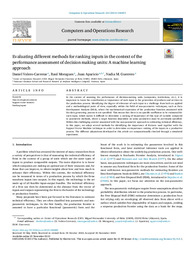Please use this identifier to cite or link to this item:
https://hdl.handle.net/11000/35046Full metadata record
| DC Field | Value | Language |
|---|---|---|
| dc.contributor.author | Moragues, Raul | - |
| dc.contributor.author | Valero-Carreras, Daniel | - |
| dc.contributor.author | Aparicio, Juan | - |
| dc.contributor.author | GUERRERO MARTÍNEZ, NADIA M. | - |
| dc.contributor.other | Departamentos de la UMH::Estadística, Matemáticas e Informática | es_ES |
| dc.date.accessioned | 2025-01-20T18:41:52Z | - |
| dc.date.available | 2025-01-20T18:41:52Z | - |
| dc.date.created | 2024 | - |
| dc.identifier.citation | Computers and Operations Research | es_ES |
| dc.identifier.issn | 1873-765X | - |
| dc.identifier.uri | https://hdl.handle.net/11000/35046 | - |
| dc.description.abstract | In the context of assessing the performance of decision-making units (companies, institutions, etc.), it is important to know the contribution or importance of each input to the generation of products and services in the production process. Identifying the degree of relevance of each input is a challenge from both an applied and a methodological point of view, especially within the field of non-parametric techniques, such as Data Envelopment Analysis (DEA), where the mathematical expression of the production function associated with the data generating process is not specified. This means that there is no specific coefficient to be estimated for each input, which makes it difficult to determine a ranking of importance of this type of variable compared to parametric methods, where a target function dependent on some parameters must be previously specified. Within this challenging context associated with the non-parametric approach to estimating technical efficiency, in this paper, we adapt several methods for identifying the importance of features used together with the Support Vector Machine technique in order to determine an importance ranking of the inputs in a productive process. The different adaptations developed in this article are computationally checked through a simulated experiment. | es_ES |
| dc.format | application/pdf | es_ES |
| dc.format.extent | 12 | es_ES |
| dc.language.iso | eng | es_ES |
| dc.publisher | Elsevier | es_ES |
| dc.relation.ispartofseries | 163 | es_ES |
| dc.rights | info:eu-repo/semantics/openAccess | es_ES |
| dc.rights.uri | http://creativecommons.org/licenses/by-nc-nd/4.0/ | * |
| dc.subject | Data envelopment analysis | es_ES |
| dc.subject | Support vector frontiers | es_ES |
| dc.subject | Ranking inputs | es_ES |
| dc.subject.other | CDU::5 - Ciencias puras y naturales::51 - Matemáticas | es_ES |
| dc.title | Evaluating different methods for ranking inputs in the context of the performance assessment of decision making units: A machine learning approach | es_ES |
| dc.type | info:eu-repo/semantics/article | es_ES |
| dc.relation.publisherversion | https://doi.org/10.1016/j.cor.2023.106485 | es_ES |

View/Open:
1-s2.0-S0305054823003490-main.pdf
783,4 kB
Adobe PDF
Share:
.png)
